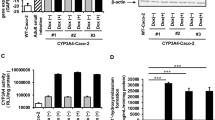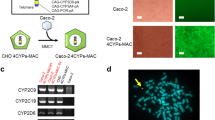Abstract
Purpose. To compare the activity of the CYP3A enzyme expressed by TC7, a cell culture model of the intestinal epithelial cell, to the activity of human intestinal CYP3A4, using terfenadine as a substrate.
Methods. The metabolism of terfenadine was investigated in intact cells and microsomal preparations from TC7, human intestine, and liver. The effect of two CYP3A inhibitors, ketoconazole and troleandomycin (TAO), on the metabolism of terfenadine was also examined.
Results. Only hydroxy-terfenadine was detected in TC7 microsomal incubations. In contrast, azacyclonol and hydroxy-terfenadine were detected in human intestinal and hepatic microsomal incubations. The Km values for hydroxy-terfenadine formation in TC7 cells, intestine and liver microsomes were 1.91, 2.5, and 1.8, μM respectively. The corresponding Vmax values were 2.11, 61.0, and 370 pmol/min/mg protein. Km values for azacyclonol in intestinal and hepatic samples were 1.44 and 0.82 μM and the corresponding Vmax values were 14 and 60 pmol/min/mg protein. The formation of hydroxy-terfenadine was inhibited by ketoconazole and TAO in human intestine and TC7 cell microsomes. The Km and Vmax values for terfenadine metabolism in intact TC7 cells were similar to those from TC7 cell microsomes.
Conclusions. Our results indicate that TC7 cells are a potentially useful alternative model for studies of CYP3A mediated drug metabolism. The CYP3A expressed by TC7 cells is not CYP3A4, but probably CYP3A5, making this cell line suitable for studies of colonic drug transport and metabolism.
Similar content being viewed by others
REFERENCES
J. C. Kolars, W. M. Awni, R. M. Merion, and P. B. Watkins. The Lancet 338:1488–1490 (1991).
W. A. Mahon, T. Inaba, and R. M. Stone. Clin. Pharmacol Ther. 22:228–233 (1977).
L. S. Kaminsky and M. J. Fasco. Toxicology 21:407–422 (1992).
J. C. Kolars, P. Schmiedlin-Ren, J. D. Schuetz, C. Fang, and P. B. Watkins. J. Clin. Invest. 90:1871–1878 (1992).
P. B. Watkins, S. A. Wrighton, E. G. Schuetz, D. T. Molowa, and P. S. Guzelian. J. Clin. Invest. 80:1029–1036 (1987).
L. Gervot, V. Carriere, P. Costet, P. Cugenenc, A. Berger, P. H. Beaune, and I. de Waziers. Env. Toxicol. Pharmacol. 2:381–388 (1996).
I. J. Hidalgo, T. J. Raub, and R. T. Borchardt. Gastroenterology 96:736–49 (1989).
K. L. Audus, R. L. Bartel, I. J. Hidalgo, and R. T. Borchardt. Pharm. Res. 7:435–451 (1990).
P. Artursson. Crit. Rev. Ther. Drug Carrier System 8:305–330 (1991).
A. Baranczyk-Kuzma, J. A. Garren, I. J. Hidalgo, and R. T. Borchardt. Life Sci. 49:1197–1206 (1991).
W. H. M. Peters and H. M. J. Roelofs. Cancer Res. 52:1886–1890 (1992).
X. Boulenc, M. Bourrie, I. Fabre, C. Roque, H. Joyeux, Y. Berger, and G. J. Fabre. J. Pharmacol Exper. Ther. 263:1471–1478 (1992).
V. Carriere, T. Lesuffleur, A. Barbat, M. Rousset, E. Dussaulx, P. Costet, I. Wazier, P. Beasune, and A. Zweibaum. FEBS Lett. 355:247–250 (1994).
C.-H. Yun, R. A. Okerholm, and F. P. Guengerich. Drug Metab. Disp. 21:403–409 (1993).
M. Jurima-Romet, K. Crawford, T. Cyr, and T. Inaba. 22:849-857 (1994).
A. D. Rodrigues, D. J. Mulford, R. D. Lee, B. W. Surber, M. J. Kukuka, J. L. Ferrero, S. B. Thomas, M. S. Shet, and R. W. Estabrook. Drug Metabo. Disp. 23:765–409 (1995).
K.-H. Ling, G. A. Leeson, S. D. Burmaster, R. H. Hook, M. K. Reith, and L. K. Cheng. Drug Metab. Disp. 23:631–636 (1995).
T. Aoyama, S. Yamano, D. J. Waxman, D. P. Lapenson, U. A. Meyer, V. Fischer, R. Tyndale, T. Inaba, W. Kalow, H. V. Gelboin, and F. J. Gonzalez. J. Biol. Chem. 264:97–105 (1989).
S. A. Wrighton, B. J. Ring, P. B. Watkins, and M. VandenBranden. Mol. Pharmacol. 38:3147–3155 (1989).
S. A. Wrighton, W. R. Brian, M.-A. Sari, M. Iwasaki, F. P. Guengerich, J. L. Raucy, D. T. Malowa, and M. VandenBranden. Mol. Pharmacol. 38:207–213 (1990).
J. C. Gorski, S. D. Hall, D. R. Jones, M. VandenBranden, and S. A. Wrighton. Biochem. Pharmacol. 47:1643–1653 (1994).
Author information
Authors and Affiliations
Corresponding author
Rights and permissions
About this article
Cite this article
Raeissi, S.D., Guo, Z., Dobson, G.L. et al. Comparison of CYP3A Activities in a Subclone of Caco-2 Cells (TC7) and Human Intestine. Pharm Res 14, 1019–1025 (1997). https://doi.org/10.1023/A:1012197110917
Issue Date:
DOI: https://doi.org/10.1023/A:1012197110917




